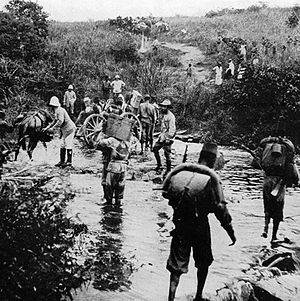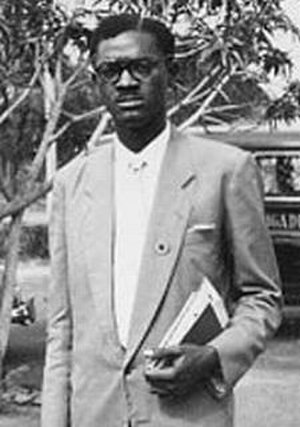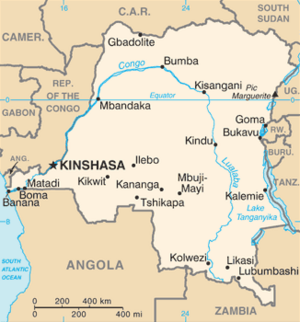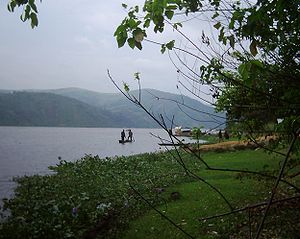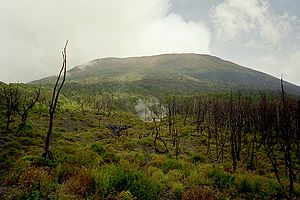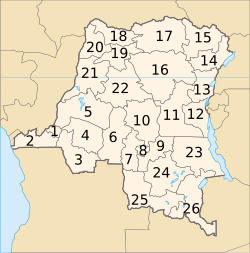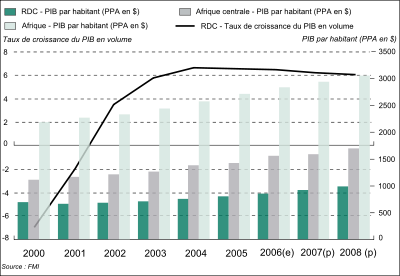Democratic Republic of the Congo
From Wikipedia, the free encyclopedia
| Democratic Republic of the Congo
République Démocratique du Congo
|
||||||
|---|---|---|---|---|---|---|
|
||||||
| Motto: Justice – Paix – Travail (French) "Justice – Peace – Work" |
||||||
| Anthem: Debout Congolais |
||||||
| Capital (and largest city) |
Kinshasaa |
|||||
| Official languages | French | |||||
| Recognised regional languages | Lingala, Kongo/Kituba, Swahili, Tshiluba | |||||
| Demonym | Congolese | |||||
| Government | Semi-Presidential Republic | |||||
| - | President | Joseph Kabila | ||||
| - | Prime Minister | Adolphe Muzito | ||||
| Independence | ||||||
| - | from Belgium | 30 June 1960 | ||||
| Area | ||||||
| - | Total | 2,344,858 km2 (12th) 905,355 sq mi |
||||
| - | Water (%) | 3.3 | ||||
| Population | ||||||
| - | 2007 United Nations estimate | 62,600,000 (21st) | ||||
| - | Density | 25/km2 (188th) 65/sq mi |
||||
| GDP (PPP) | 2007 estimate | |||||
| - | Total | $19.021 billion[1] | ||||
| - | Per capita | $311[1] | ||||
| GDP (nominal) | 2007 estimate | |||||
| - | Total | $10.423 billion[1] | ||||
| - | Per capita | $170[1] | ||||
| HDI (2008) | ▼ 0.361 (low) (177th) | |||||
| Currency | Congolese franc (CDF) |
|||||
| Time zone | WAT, CAT (UTC+1 to +2) | |||||
| - | Summer (DST) | not observed (UTC+1 to +2) | ||||
| Drives on the | right | |||||
| Internet TLD | .cd | |||||
| Calling code | 243 | |||||
| a Estimate is based on regression; other PPP figures are extrapolated from the latest International Comparison Programme benchmark estimates. | ||||||
The Democratic Republic of the Congo (French: République démocratique du Congo), is a country in central Africa with a small length of Atlantic coastline. It is the third largest country (by area) in Africa.
In order to distinguish it from the neighbouring Republic of the Congo, the Democratic Republic of the Congo is often referred to as DR Congo, DRC, or RDC, or is called Congo-Kinshasa after the capital Kinshasa (in contrast to Congo-Brazzaville for its neighbour).
The name "Congo" refers to the river Congo, also known as the river Zaire. (The river name Congo is related to the name of the Bakongo ethnic group).
The Democratic Republic of the Congo was formerly, in turn, the Congo Free State, Belgian Congo, Congo-Léopoldville, Congo-Kinshasa, and Zaire (or Zaïre in French). Though it is located in the Central African UN subregion, the nation is economically and regionally affiliated with Southern Africa as a member of the Southern African Development Community (SADC).
DR Congo borders the Central African Republic and Sudan on the North; Uganda, Rwanda, and Burundi on the East; Zambia and Angola on the South; the Republic of the Congo on the West; and is separated from Tanzania by Lake Tanganyika on the East.[2] The country enjoys access to the ocean through a 40-kilometre (25 mile) stretch of Atlantic coastline at Muanda and the roughly nine-kilometre wide mouth of the Congo river which opens into the Gulf of Guinea.
The Second Congo War, beginning in 1998, devastated the country greatly and involved seven foreign armies and is sometimes referred to as the "African World War".[3] Despite the signing of peace accords in 2003, fighting continues in the east of the country. In eastern Congo, the prevalence and intensity of rape and other sexual violence is described as the worst in the world.[4] The war is the world's deadliest conflict since World War II, killing 5.4 million people.[5][6]
Contents |
[edit] History of Name
Formerly the Belgian colony of the Belgian Congo, the country's post-independence name was the Republic of the Kongo until August 1, 1964,[7] when its name was changed to Democratic Republic of the Congo (to distinguish it from the neighboring Republic of the Congo).[8] On October 27, 1971,[7] then-President Mobutu renamed the country Zaire, from a Portuguese mispronunciation of the Kikongo word nzere or nzadi, which translates to "the river that swallows all rivers."[9]
Following the First Congo War which led to the overthrow of Mobutu in 1997 , the country was renamed Democratic Republic of the Congo.
[edit] History
[edit] Congolese pre-history
A wave of early peoples is identified in the Northern and North-Western parts of Central Africa during the second millennium BP (Before Present).[citation needed] They produced food (pearl millet), maintained domestic livestock, and developed a kind of arboriculture mainly based on the oil palm[citation needed] From 3,500 BP to 2,000 BP, starting from a nucleus area in South Cameroon on both banks of the Sanaga River, the first Neolithic peopling of northern and western Central Africa can be followed south-eastwards and southwards.[citation needed] In D.R. Congo the first villages in the vicinity of Mbandaka and the Tumba Lake are known as the 'Imbonga Tradition', from around 2,600 BP. In Lower Congo, north of the Angolan border, it is the 'Ngovo Tradition' around 2,300 BP that shows the arrival of the Neolithic wave of advance.[citation needed]
In Kivu, across the country to the east, the 'Urewe Tradition' villages first appeared about 2,600 BP. The few archaeological sites known in Congo are a western extension of the 'Urewe' Culture which has been found chiefly in Uganda, Rwanda, Burundi, and Western Kenya and Tanzania.[citation needed] From the start of this tradition, the people knew iron smelting, as is evidenced by several iron-smelting furnaces excavated in Rwanda and Burundi.[citation needed]
The earliest evidence further to the west is known in Cameroon, and near to the small town of Bouar in Central Africa. Though further studies are needed to establish a better chronology for the start of iron production in Central Africa, the Cameroonian data places iron smelting north of the Equatorial Forest around 2,600 BP to 2,500 BP.[citation needed] This technology developed independently from the previous Neolithic expansion, some 900 years later. As fieldwork done by a German team shows, the Congo River network was slowly settled by food-producing villagers going upstream in the forest. Work from a Spanish project in the Ituri area further east suggests villages reached there only around 800 BP.[citation needed]
The supposedly Bantu-speaking Neolithic, and then iron-producing, villagers added to and displaced the indigenous Pygmy populations (also known in the region as the "Bitwa" or "Twa") into secondary parts of the country.[citation needed] Subsequent migrations from the Darfur and Kordofan regions of Sudan into the north-east, as well as East Africans migrating into the eastern Congo added to the mix of ethnic groups. The Bantu-speakers imported a mixed economy made up of agriculture, small-stock raising, fishing, fruit collecting, hunting and arboriculture before 3,500 BP; iron-working techniques, possibly from West Africa, are a much later addition.[citation needed] The villagers established the Bantu language family as the primary set of tongues for the Congolese.[citation needed]
[edit] The Congo Free State (1877–1908)
European exploration and administration took place from the 1870s until the 1920s. It was first led by Sir Henry Morton Stanley, who undertook his explorations under the sponsorship of King Leopold II of Belgium. Leopold had designs on what was to become the Congo as a colony. In a succession of negotiations, Leopold, professing humanitarian objectives in his capacity as chairman of the Association Internationale Africaine, played one European rival against the other.
Leopold formally acquired rights to the Congo territory at the Conference of Berlin in 1885. He made the land his private property and named it the Congo Free State. Leopold's regime began various infrastructure projects, such as construction of the railway that ran from the coast to the capital of Leopoldville (now Kinshasa). It took years to complete. Nearly all such projects were aimed at increasing the capital which Leopold and his associates could extract from the colony, leading to exploitation of Africans.
In the Free State, colonists brutalized the local population to produce rubber, for which the spread of autos and development of rubber tires created a growing international market. The sale of rubber made a fortune for Leopold, who built several buildings in Brussels and Ostend to honour himself and his country. To enforce the rubber quotas, the army, the Force Publique (FP), was called in. The Force Publique made the practice of cutting off the limbs of the natives as a means of enforcing rubber quotas a matter of policy; this practice was widespread. During the period 1885–1908, between 5 and 15 (the commonly accepted figure is about 10) million Congolese died as a consequence of exploitation and diseases. A government commission later concluded that the population of the Congo had been "reduced by half" during this period.[10] The actions of the Free State's administration sparked international protests led by E. D. Morel and British diplomat/Irish patriot Roger Casement, whose 1904 report on the Congo condemned the practice. Famous writers such as Mark Twain also protested, and Joseph Conrad's novella Heart of Darkness was set in Congo Free State.
In 1908, the Belgian parliament, despite initial reluctance, bowed to international pressure (especially that from Great Britain) and took over the Free State as a Belgian colony from the king. From then on, it was called the Belgian Congo and was under the rule of the elected Belgian government,
[edit] Political crisis (1960–1965)
In May 1960 in a growing nationalist movement, the Mouvement National Congolais or MNC Party, led by Patrice Lumumba, won the parliamentary elections. The party appointed Lumumba as Prime Minister. The parliament elected Joseph Kasavubu, of the Alliance des Bakongo (ABAKO) party as President. Other parties that emerged included the Parti Solidaire Africain (or PSA) led by Antoine Gizenga, and the Parti National du Peuple (or PNP) led by Albert Delvaux and Laurent Mbariko. (Congo 1960, dossiers du CRISP, Belgium) The Belgian Congo achieved independence on June 30, 1960 under the name "Republic of Congo" or "Republic of the Congo" ("République du Congo"). Shortly after independence, the provinces of Katanga (led by Moise Tshombe) and South Kasai engaged in secessionist struggles against the new leadership. Most of the 100,000 Europeans who had remained behind after independence fled the country,[11] opening the way for Congolese to replace the European military and administrative elite.[12]
As the French colony of Middle Congo (Moyen Congo) also chose the name "Republic of Congo" upon achieving its independence, the two countries were more commonly known as "Congo-Léopoldville" and "Congo-Brazzaville", after their capital cities. In 1966, Joseph Mobutu changed the country's official name to "Democratic Republic of the Congo". In 1971 it was changed again to "Republic of Zaïre".
On September 5, 1960, Kasavubu dismissed Lumumba from office. Lumumba declared Kasavubu's action "unconstitutional" and a crisis between the two leaders developed. (cf. Sécession au Katanga - J.Gerald-Libois -Brussels- CRISP) Lumumba had previously appointed Joseph Mobutu chief of staff of the new Congo army, Armee Nationale Congolaise (ANC). Taking advantage of the leadership crisis between Kasavubu and Lumumba, Mobutu garnered enough support within the army to create mutiny. With financial support from the United States and Belgium, Mobutu paid his soldiers privately. The aversion of Western powers to communism and leftist ideology influenced their decision to finance Mobutu's quest to maintain "order" in the new state by neutralizing Kasavubu and Lumumba in a coup by proxy.
On January 17, 1961, Katangan forces and Belgian paratroops, supported by the United States' and Belgium's intent on copper and diamond mines in Katanga and South Kasai, kidnapped and executed Patrice Lumumba. Amidst widespread confusion and chaos, a temporary government was led by technicians (Collège des Commissaires) with Evariste Kimba. The Katanga secession was ended in January 1963 with the assistance of UN forces. Several short-lived governments, of Joseph Ileo, Cyrille Adoula, and Moise Tshombe, took over in quick succession. (See the book The Assassination of Lumumba by Ludo de Witte.)
[edit] Zaire (1971–1997)
Following five years of instability and civil unrest, Joseph-Désiré Mobutu, now Lieutenant General, overthrew Kasavubu in a 1965 coup. He had the support of the United States because of his staunch opposition to Communism. Western powers appeared to believe this would make him a roadblock to Communist schemes in Africa. Historians[who?] have also argued that Western support for Mobutu was related to his allowing businesses to export the many natural resources of Zaire without worrying about environmental, labour, or other regulations. A one-party system was established, and Mobutu declared himself head of state. He periodically held elections in which he was the only candidate. Relative peace and stability was achieved; however, Mobutu's government was guilty of severe human rights violations, political repression, a cult of personality and corruption. (Mobutu demanded every Congolese bank note printed with his image, hanging of his portrait in all public buildings, most businesses, and on billboards; and it was common for ordinary people to wear his likeness on their clothing.) Corruption became so prevalent the term "le mal Zairois" or "Zairean Sickness"[citation needed] was coined, reportedly by Mobutu himself.[citation needed] By 1984, Mobutu was said to have $4 billion (USD), an amount close to the country's national debt, deposited in a personal Swiss bank account. International aid, most often in the form of loans, enriched Mobutu while he allowed national infrastructure such as roads to deteriorate to as little as one-fourth of what had existed in 1960. With the embezzlement of government funds by Mobutu and his associates, Zaire became a "kleptocracy."
In a campaign to identify himself with African nationalism, starting on June 1, 1966, Mobutu renamed the nation's cities: Léopoldville became Kinshasa [the country was now Democratic Republic of The Congo – Kinshasa], Stanleyville became Kisangani, and Elisabethville became Lubumbashi. This renaming campaign was completed in the 1970s. In 1971, Mobutu renamed the country the Republic of Zaire, its fourth name change in 11 years and its sixth overall. The Congo River was renamed the Zaire River. In 1972, Mobutu renamed himself Mobutu Sese Seko Kuku Ngbendu Wa Za Banga. (roughly translated as The Great Unstoppable Warrier who goes from Victory to Victory)
During the 1970s and 1980s, Mobutu was invited to visit the United States on several occasions, meeting with U.S. Presidents Richard Nixon, Ronald Reagan and George H. W. Bush. In June 1989, Mobutu was the first African head of state invited for a state visit with newly elected President Bush.[13] Following the collapse of the Soviet Union, however, U.S. relations with Mobutu cooled, as he was no longer deemed necessary as a Cold War ally. Opponents within Zaire stepped up demands for reform. This atmosphere contributed to Mobutu's declaring the Third Republic in 1990, whose constitution was supposed to pave the way for democratic reform. The reforms turned out to be largely cosmetic. Mobutu continued in power until conflict forced him to flee Zaire in 1997.
The nation chose to reclaim its name of the Democratic Republic of the Congo. Zaire carried strong connections to the rule of Mobutu.
[edit] Civil Wars
By 1996, tensions from the neighboring Rwanda war and genocide had spilled over to Zaire. Rwandan Hutu militia forces (Interahamwe), who had fled Rwanda following the ascension of a Tutsi-led government, had been using Hutu refugees camps in eastern Zaire as a basis for incursion against Rwanda. These Hutu militia forces soon allied with the Zairian armed forces (FAZ) to launch a campaign against Congolese ethnic Tutsis in eastern Zaire. In turn, the Tutsis formed a militia and erupted in rebellion against Mobutu. They were soon joined by various opposition groups and supported by several countries, including Rwanda and Uganda. This coalition, led by Laurent-Desire Kabila, became known as the Alliance des Forces Démocratiques pour la Libération du Congo-Zaïre (AFDL). They were seeking the broader goal of ousting Mobutu. In May 1997, Mobutu left the country, and Kabila marched into Kinshasa, naming himself president and reverted the name of the country to the Democratic Republic of Congo.

The Movement for the Liberation of Congo (MLC), led by the warlord Jean-Pierre Bemba, attacked in 1998, backed by Rwandan and Ugandan troops. Angola, Zimbabwe and Namibia became involved militarily on the side of the government. Kabila was assassinated in 2001 and was succeeded by his son Joseph, who upon taking office called for multilateral peace talks to end the war. In February 2001 a peace deal was brokered between Kabila, Rwanda and Uganda lead to the apparent withdrawal of foreign troops. UN peacekeepers, MONUC, arrived in April 2001. The conflict was reignited in January 2002 by ethnic clashes in the northeast and both Uganda and Rwanda then halted their withdrawal and sent in more troops. Talks between Kabila and the rebel leaders led to the signing of a peace accord in which Kabila would share power with former rebels. By June 2003 all foreign armies except those of Rwanda had pulled out of Congo. Much of the conflict was focused on gaining control of substantial natural resources in the country, including diamonds, copper, zinc, and coltan.[15]
DR Congo had a transitional government until the election was over. A constitution was approved by voters and on July 30, 2006 the Congo held its first multi-party elections since independence in 1960. After this Joseph Kabila took 45% of the votes and his opponent Jean-Pierre Bemba took 20%. That was the origin of a fight between the two parts from August 20-22, 2006 in the streets of the capital, Kinshasa. Sixteen people died before police and UN mission MONUC took control of the city. A new election was held on October 29, 2006, which Kabila won with 70% of the vote. Bemba has made multiple public statements saying the election has "irregularities," despite the fact that every neutral observer has praised the elections. On December 6, 2006 the Transitional Government came to an end as Joseph Kabila was sworn in as President.
The fragility of the state has allowed continued conflict and human rights abuses. In the ongoing Kivu conflict, Democratic Forces for the Liberation of Rwanda (FDLR) continues to threaten the Rwandan border and the Banyamulenge, and where Rwanda supports RCD-Goma rebels against Kinshasa; a rebel offensive at the end of October 2008 caused a refugee crisis. In Ituri, where MONUC has proved unable to contain the numerous militia and groups driving the Ituri conflict. In the northeast, Joseph Kony's LRA moved from their original bases in Uganda, where they have fought a 20-year rebellion, and South Sudan to DR Congo in 2005 and have set up camps in the Garamba National Park.[16][17] In northern Katanga, the Mai-Mai created by Laurent Kabila slipped out of the control of Kinshasa. The war is the world's deadliest conflict since World War II killing 5.4 million people.[18]
Today at the dawn of 2009, people in the Congo are still dying at a rate of an estimated 45,000 per month and already 2,700,000 people have died since 2004. This death toll is due to widespread disease and famine; reports indicate that almost half of the individuals killed are children under the age of 5. The aftermath of the war has truly gutted the country. This death rate has been prevalent since efforts at rebuilding the nation began in 2004. [19]
[edit] Geography
The Congo is situated at the heart of the west-central portion of sub-Saharan Africa and is bounded by (clockwise from the southwest) Angola, the South Atlantic Ocean, the Republic of Congo, the Central African Republic, the Sudan, Uganda, Rwanda, Burundi, Tanzania across Lake Tanganyika, and Zambia. The country straddles the Equator, with one-third to the North and two-thirds to the South. The size of Congo, 2,345,408 square kilometres (905,567 sq mi), is slightly greater than the combined areas of Spain, France, Germany, Sweden, and Norway.
As a result of its equatorial location, the Congo experiences large amounts of precipitation and has the highest frequency of thunderstorms in the world. The annual rainfall can total upwards of 80 inches (200 cm) in some places, and the area sustains the second largest rain forest in the world (after that of the Amazon). This massive expanse of lush jungle covers most of the vast, low-lying central basin of the river, which slopes toward the Atlantic Ocean in the West. This area is surrounded by plateaus merging into savannas in the south and southwest, by mountainous terraces in the west, and dense grasslands extending beyond the Congo River in the north. High, glaciated mountains are found in the extreme eastern region.
The tropical climate has also produced the Congo River system which dominates the region topographically along with the rainforest it flows through, though they are not mutually exclusive. The name for the Congo state is derived in part from the river. The river basin (meaning the Congo River and all of its myriad tributaries) occupies nearly the entire country and an area of nearly one million square kilometers (400,000 sq mi). The river and its tributaries (major offshoots include the Kasai, Sangha, Ubangi, Aruwimi, and Lulonga) form the backbone of Congolese economics and transportation. They have a dramatic impact on the daily lives of the people.

The sources of the Congo are in the highlands and mountains of the East African Rift, as well as Lake Tanganyika and Lake Mweru. The river flows generally west from Kisangani just below Boyoma Falls, then gradually bends southwest, passing by Mbandaka, joining with the Ubangi River, and running into the Pool Malebo (Stanley Pool). Kinshasa and Brazzaville are on opposite sides of the river at the Pool (see NASA image). Then the river narrows and falls through a number of cataracts in deep canyons (collectively known as the Livingstone Falls), and then running past Boma into the Atlantic Ocean. The river also has the second-largest flow and the second-largest watershed of any river in the world (trailing the Amazon in both respects). The river and a forty-kilometre-wide strip of land on its north bank provide the country's only outlet to the Atlantic.

The previously mentioned Great Rift Valley, in particular the Eastern Rift, plays a key role in shaping the Congo's geography. Not only is the northeastern section of the country much more mountainous, but due to the rift's tectonic activities, this area also experiences low levels of volcanic activity. The geologic activity in this area also created the famous African Great Lakes, three of which lie on the Congo's eastern frontier: Lake Albert (known previously as Lake Mobutu), Lake Edward, and Lake Tanganyika. Perhaps most important of all, the Rift Valley has exposed an enormous amount of mineral wealth throughout the south and east of the Congo, making it accessible to mining. Cobalt, copper, cadmium, industrial and gem-quality diamonds, gold, silver, zinc, manganese, tin, germanium, uranium, radium, bauxite, iron ore, and coal are all found in plentiful supply, especially in the Congo's southeastern Katanga region.
On January 17, 2002 Mount Nyiragongo erupted in Congo, with the lava running out at 40 mph (60 km/h) and 50 yards (50 m) wide. One of the three streams of lava flowed through the nearby city of Goma, killing 45 and leaving 120,000 homeless. Four hundred thousand people were evacuated from the city during the eruption. The lava poisoned the water of Lake Kivu, killing fish. Only two planes left the local airport because of the possibility of the explosion of stored petrol. The lava passed the airport but ruined the runway, entrapping several airplanes. Six months after the 2002 eruption, nearby Mount Nyamuragira also erupted, and again more recently in 2006. Both volcanos remain active.
[edit] Provinces and territories
Formerly the country was divided into eleven provinces, Kinshasa, Province Orientale, Kasaï Oriental, Kasaï Occidental, Maniema, Katanga, Sud-Kivu, Nord-Kivu, Bas-Congo, Équateur and Bandundu. However, the constitution approved in 2005 divided the country into 26 fairly autonomous provinces, including the capital, Kinshasa to be formed by 18 February 2009. These are subdivided into 192 territories (fr. territoires, sing. territoire).
|
|
The provinces are subdivided into territories.
[edit] Population of major cities (2008)
| City | Population (2008) |
|---|---|
| Kinshasa | 9,500,000 |
| Mbuji-Mayi | 2,500,000 |
| Lubumbashi | 1,700,000 |
| Kananga | 1,400,000 |
| Kisangani | 1,200,000 |
| Kolwezi | 1,100,000 |
| Mbandaka | 850,000 |
| Likasi | 600,000 |
| Boma | 600,000 |
[edit] Government
After four years of interim between two constitutions that established different political institution at the various levels of all branches of government, as well as different administrative divisions of the country, politics in the Democratic Republic of the Congo are settling into a stable presidential democratic republic.
The transitional constitution[20] established a system composed of a bicameral legislature with a Senate and a National Assembly. The Senate has, among other things, the charge of drafting the new constitution of the country. The executive branch is vested in a 60-member cabinet, headed by a pentarchy of a President, and four vice presidents. The President is also the Commander-in Chief of the Armed forces. The unusual organization of the executive — considering the large number of vice presidents — has earned it the very official nickname of "The 1 + 4".[citation needed]
The transition constitution also established a relatively independent judiciary, headed by a Supreme Court with constitutional interpretation powers.
The 2006 constitution, also known as the Constitution of the Third Republic, came into effect in February 2006. It has concurrent authority, however, with the transitional constitution until the inauguration of the elected officials who will emerge from the July 2006 elections. Under this constitution, the legislature will remain bicameral; the executive will be concomitantly undertaken by a President and the government; and the latter will be led by a Prime Minister, appointed from the party with the majority at the National Assembly. The government – not the President – is responsible to the Parliament.
The provincial governments will gain new powers, under the new decentralized model, with the creation of provincial parliaments, with oversight over the Governor, head of the provincial government, whom they elect.
The new constitution also sees the disappearance of the Supreme Court, which is divided into three new institutions. The constitutional interpretation prerogative of the Supreme Court will be held by the Constitutional Court.
[edit] Economy
The economy of the Democratic Republic of the Congo, a nation endowed with resources of vast potential wealth, has declined drastically since the mid-1980s. The two recent conflicts (the First and Second Congo Wars), which began in 1996, have dramatically reduced national output and government revenue, have increased external debt, and have resulted in deaths of more than five million people from war, and associated famine and disease. Foreign businesses have curtailed operations due to uncertainty about the outcome of the conflict, lack of infrastructure, and the difficult operating environment. The war has intensified the impact of such basic problems as an uncertain legal framework, corruption, inflation, and lack of openness in government economic policy and financial operations. Malnutrition affects approximately two thirds of the country's population. Conditions improved in late 2002 with the withdrawal of a large portion of the invading foreign troops. A number of International Monetary Fund and World Bank missions have met with the government to help it develop a coherent economic plan, and President Joseph Kabila has begun implementing reforms. Much economic activity lies outside the GDP data. A United Nations Human Development Index report shows human development to be one of the worst in decades.
The Congo is the world's largest producer of cobalt ore,[21] and a major producer of copper and industrial diamonds. It has significant deposits of tantalum, which is used in the fabrication of electronic components in computers and mobile phones. In 2002, tin was discovered in the east of the country, but, to date, mining has been on a small scale [22]. Smuggling of coltan and cassiterite, the ores of tantalum and tin, respectively, has helped fuel the war in the Eastern Congo. Katanga Mining Limited, a London-based company, owns the Luilu Metallurgical Plant, which has a capacity of 175,000 tonnes of copper and 8,000 tonnes of cobalt per year, making it the largest cobalt refinery in the world. After a major rehabilitation program, the company restarted copper production in December 2007 and cobalt production in May 2008[23]. It has one of the ten last ranks among the countries on the Corruption Perception Index.
In 2007, The World Bank decided to grant the Democratic Republic of Congo up to $1.3 billion in assistance funds over the next three years.[24]
The Democratic Republic of Congo is in the process of becoming a member of the Organization for the Harmonization of Business Law in Africa (OHADA).[25]
[edit] Demographics
The United Nations 2007 estimated the population at 62.6 million people, having increased rapidly despite the war from 46.7 million in 1997. As many as 250 ethnic groups have been identified and named. The most numerous people are the Kongo, Luba, and Mongo. Although seven hundred local languages and dialects are spoken, the linguistic variety is bridged both by widespread use of French and intermediary languages such as Kongo, Tshiluba, Swahili, and Lingala.
[edit] Status of women

The United Nations Committee on the Elimination of All Forms of Discrimination against Women in 2006 expressed concern that in the post-war transition period, the promotion of women’s human rights and gender equality is not seen as a priority.[26]
In eastern Congo, the prevalence and intensity of rape and other sexual violence is described as the worst in the world.[27] A 2006 report by the African Association for the Defence of Human Rights prepared for that committee provides a broad overview of issues confronting women in the DRC in law and in daily life.[28] They have been raped during warfare and kept as slaves for soldiers. When the women are released, most killed themselves or checked into a hospital where they would die.
The war has made the life of women more precarious. Violence against women seems to be perceived by large sectors of society to be normal.[29] In July 2007, the International Committee of the Red Cross expressed concern about the situation in eastern DRC.[30] A phenomenon of 'pendulum displacement' has developed, where people hasten at night to safety. According to the UN Special Rapporteur on Violence, Yakin Ertürk, who toured eastern Congo in July 2007, violence against women in North and South Kivu included “unimaginable brutality”. "Armed groups attack local communities, loot, rape, kidnap women and children and make them work as sexual slaves," Ertürk said.[31] A local initiative by women in Bukavu aims for recovery from violence based on women's own empowerment.[32]
[edit] Religion
Christianity is the majority religion in the Democratic Republic of the Congo, followed by about 80% of the population. Denominations include Roman Catholic 50%, Protestant 20%, Kimbanguist 10%.[33] Kimbanguism was seen as a threat to the colonial regime and was banned by the Belgians. Kimbanguism, officially "the church of Christ on Earth by the prophet Simon Kimbangu", now has about three million members,[33] primarily among the Bakongo of Bas-Congo and Kinshasa. The largest concentration of Christians following William Branham is in the Democratic Republic of the Congo, where it is estimated that there are up to 2,000,000 followers.[citation needed] Sixty-two of the Protestant denominations in the country are federated under the umbrella of the Church of Christ in Congo or CCC (in French, Église du Christ au Congo or ECC). It is often simply referred to as 'The Protestant Church', since it covers most of the 20% of the population who are Protestants.
| Religion in the Democratic Republic of the Congo | ||||
|---|---|---|---|---|
| religion | percent | |||
| Roman Catholic | 50% | |||
| Protestant | 20% | |||
| Kimbanguist | 10% | |||
| Islam | 10% | |||
| Indigenous | 10% | |||
Of the remaining 20% of the population, half are Muslim,[35] and the rest follow traditional beliefs or syncretic sects. Islam was introduced and mainly spread by Arabic merchants[36] involved in the ivory trade. Traditional religions embody such concepts as monotheism, animism, vitalism, spirit and ancestor worship, witchcraft, and sorcery and vary widely among ethnic groups. The syncretic sects often merge Christianity with traditional beliefs and rituals, and may not be accepted by mainstream churches as part of Christianity.
[edit] Languages
There are an estimated total of 242 languages spoken in the Democratic Republic of the Congo. Out of these, only four have the status of national languages: Kikongo (Kituba), Lingala, Tshiluba and Swahili.
Lingala was made the official language of the colonial army, the "Force Publique" under Belgian colonial rule. But since the recent rebellions, a good part of the army in the East also uses Swahili where it is prevalent.
French is the official language of the country. It is meant to be an ethnically neutral language, to ease communication among the many different ethnic groups of the Congo.
When the country was a Belgian colony, it had already instituted teaching and use of the four national languages in primary schools, making it one of the few African nations to have had literacy in local languages during the European colonial period.
[edit] Culture

The culture of the Democratic Republic of the Congo reflects the diversity of its hundreds of ethnic groups and their differing ways of life throughout the country — from the mouth of the River Congo on the coast, upriver through the rainforest and savanna in its centre, to the more densely populated mountains in the far east. Since the late 19th century, traditional ways of life have undergone changes brought about by colonialism, the struggle for independence, the stagnation of the Mobutu era, and most recently, the First and Second Congo Wars. Despite these pressures, the customs and cultures of the Congo have retained much of their individuality. The country's 60 million inhabitants are mainly rural. The 30 percent who live in urban areas have been the most open to Western influences.
Another notable feature in Congo culture is its sui generis music. The DROC has blended its ethnic musical sources with Cuban rumba, and merengue to give birth to soukous. Influential figures of soukous and its offshoots: N'dombolo and Rumba rock, are Franco Luambo, Tabu Ley, Lutumba Simaro, Papa Wemba, Koffi Olomide, Kanda Bongo, Ray Lema, Mpongo Love, Abeti Masikini, Reddy Amisi, [Pasnas] Pepe Kalle and Nyoka Longo.[citation needed]
Other African nations produce music genres that are derived from Congolese soukous. Some of the African bands sing in Lingala, one of the main languages in the DRC. The same Congolese soukous, under the guidance of "le sapeur", Papa Wemba, has set the tone for a generation of young men always dressed up in expensive designers' clothes.
The Congo is also known for its art. Traditional art includes masks and wooden statues. Notable contemporary artists and fashion designers are Chéri Samba and Odette Maniema Krempin.[citation needed]
[edit] Education
The education system in the Democratic Republic of the Congo is governed by three government ministries: the Ministère de l’Enseignement Primaire, Secondaire et Professionnel (MEPSP), the Ministère de l’Enseignement Supérieur et Universitaire (MESU) and the Ministère des Affaires Sociales (MAS). The educational system in the DRC is similar to that of Belgium. In 2002, there were over 19,000 primary schools serving 160,000 students; and 8,000 secondary schools serving 110,000 students.
However, primary school education in the Democratic Republic of the Congo is neither compulsory, free nor universal, and many children are not able to go to school because parents were unable to pay the enrollment fees.[37] Parents are customarily expected to pay teachers' salaries.[37] In 1998, the most recent year for which data are available, the gross primary enrollment rate was 50 percent.[37] Gross enrollment ratios are based on the number of students formally registered in primary school and therefore do not necessarily reflect actual school attendance.[37] In 2000, 65 percent of children ages 10 to 14 years were attending school.[37] As a result of the 6-year civil war, over 5.2 million children in the country receive no education.[37]
[edit] Flora and fauna

The rainforests of the Democratic Republic of the Congo contain great biodiversity, including many rare and endemic species, such as both species of chimpanzee: the common chimpanzee and the bonobo (also known as the Pygmy Chimpanzee), mountain gorilla, okapi and white rhino. Five of the country's national parks are listed as World Heritage Sites: the Garumba, Kahuzi-Biega, Salonga and Virunga National Parks, and the Okapi Wildlife Reserve. The civil war and resultant poor economic conditions have endangered much of this biodiversity. Many park wardens were either killed or could not afford to continue their work. All five sites are listed by UNESCO as World Heritage In Danger. The Democratic Republic of the Congo is the most biodiverse African country.[38]
Over the past century or so, the DRC has developed into the center of what has been called the Central African "bushmeat" problem, which is regarded by many as a major environmental, as well as, socio-economic crisis. "Bushmeat" is another word for the meat of wild animals. It is typically obtained through trapping, usually with wire snares, or otherwise with shotguns or arms originally intended for use in the DRC's numerous military conflicts.
The "bushmeat crisis" has emerged in the DRC mainly as a result of the poor living conditions of the Congolese people. A rising population combined with deplorable economic conditions has forced many Congolese to become dependent on bushmeat, either as a means of acquiring income (hunting the meat and selling), or are dependent on it for food. Unemployment and urbanization throughout Central Africa have exacerbated the problem further by turning cities like the urban sprawl of Kinshasa into the prime market for bushmeat.
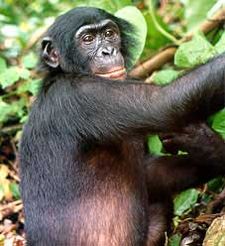
This combination has caused not only widespread endangerment of local fauna, but has forced humans to trudge deeper into the wilderness in search of the desired animal meat. This overhunting results in the deaths of more animals and makes resources even more scarce for humans. The hunting has also been facilitated by the extensive logging prevalent throughout the Congo's rainforests (from corporate logging, in addition to farmers clearing out forest in order to create areas for agriculture), which allows hunters much easier access to previously unreachable jungle terrain, while simultaneously eroding away at the habitats of animals.[39] Deforestation is accelerating in Central Africa.[40]
A case that has particularly alarmed conservationists is that of primates. The Congo is inhabited not only by two distinct species of chimpanzee — the Common chimpanzee (Pan troglodytes) and the bonobo (Pan paniscus) - but by the gorilla as well. It is the only country in the world in which bonobo are found in the wild. The two species of chimpanzees, along with gorillas, are the closest living evolutionary relatives to humans. Much concern has been raised about Great ape extinction. Because of hunting and habitat destruction, the chimpanzee and the gorilla, both of whose population once numbered in the millions have now dwindled down to only about 200,000 per species. Gorillas and both species of chimpanzee are classified as Endangered by the World Conservation Union, as well as the okapi, which is also native to the area geography.
[edit] Transport
Ground transport in the Democratic Republic of Congo has always been difficult. The terrain and climate of the Congo Basin present serious barriers to road and rail construction, and the distances are enormous across this vast country. Furthermore, chronic economic mismanagement and internal conflict has led to serious under-investment over many years.
On the other hand, the Democratic Republic of Congo has thousands of kilometres of navigable waterways, and traditionally water transport has been the dominant means of moving around approximately two-thirds of the country.
All air carriers certified by the Democratic Republic of the Congo have been banned from European Union airports by the European Commission, because of inadequate safety standards.[41]
[edit] See also
[edit] References
- ^ a b c d "Democratic Republic of the Congo". International Monetary Fund. http://www.imf.org/external/pubs/ft/weo/2008/02/weodata/weorept.aspx?sy=2004&ey=2008&scsm=1&ssd=1&sort=country&ds=.&br=1&c=636&s=NGDPD%2CNGDPDPC%2CPPPGDP%2CPPPPC%2CLP&grp=0&a=&pr.x=57&pr.y=2. Retrieved on 2008-10-09.
- ^ Central Intelligence Agency (10 January 2006). "Democratic Republic of the Congo". CIA — The World Factbook. ISSN 1553-8133. https://www.cia.gov/library/publications/the-world-factbook/geos/cg.html.
- ^ See "Rumblings of war in heart of Africa" by Abraham McLaughlin and Duncan Woodside The Christian Science Monitor 23 June 2004 and "World War Three" by Chris Bowers My Direct Democracy 24 July 2006
- ^ [http://www.washingtonpost.com/wp-dyn/content/article/2007/09/08/AR2007090801194.html Prevalence of Rape in E.Congo Described as Worst in World}
- ^ The deadliest war in the world
- ^ Congo War driven crisis kills 45,000 a month
- ^ a b "Zaire: Post-Independence Political Development", Library of Congress
- ^ Prior to this, the two countries were commonly distinguished by their capitals, with DRC called Congo-Kinshasa and the RC called Congo-Brazzaville
- ^ (Peter Forbath, The River Congo, p. 19)
- ^ King Leopold's Ghost, Adam Hochschild (1999) ISBN 0-618-00190-5 Houghton Mifflin Books
- ^ http://www.historylearningsite.co.uk/united_nations_congo.htm
- ^ "Hearts of Darkness", allacademic.com
- ^ "Zaire's Mobutu Visits America," by Michael Johns, Heritage Foundation Executive Memorandum #239, June 29, 1989.
- ^ "Congo war-driven crisis kills 45,000 a month-study". Reuters. 2008-01-22. http://www.alertnet.org/thenews/newsdesk/L22802012.htm.
- ^ Country Profiles
- ^ Congo terror after LRA rebel raids
- ^ thousands flee LRA in DR Congo
- ^ The deadliest war in the world
- ^ http://www.nytimes.com/2008/01/23/world/africa/23congo.html
- ^ Full text of constitution (French)
- ^ "Cobalt: World Mine Production, By Country". http://www.indexmundi.com/en/commodities/minerals/cobalt/cobalt_t8.html. Retrieved on 2008-06-30.
- ^ "Congo’s Riches, Looted by Renegade Troops, NY Times, 11/15/08". http://www.nytimes.com/2008/11/16/world/africa/16congo.html?scp=2&sq=congo&st=nyt.
- ^ "Katanga Project Update and 2Q 2008 Financials, Katanga Mining Limited, 8/12/08". http://www.katangamining.com/kat/media/newsreleases/news2008/2008-08-12/.
- ^ "World Bank Pledges $1 Billion to Democratic Republic of Congo". VOA News (Voice of America). 10 March 2007. http://voanews.com/english/archive/2007-03/2007-03-10-voa4.cfm. Retrieved on 25 December 2008.
- ^ OHADA.com: The business law portal in Africa, http://www.ohada.com/index.php, retrieved on 2009-03-22
- ^ "Concluding comments of the Committee on the Elimination of Discrimination against Women: Democratic Republic of the Congo" (PDF). http://www.un.org/womenwatch/daw/cedaw/cedaw36/cc/DRC/0647846E.pdf.
- ^ [http://www.washingtonpost.com/wp-dyn/content/article/2007/09/08/AR2007090801194.html Prevalence of Rape in E.Congo Described as Worst in World}
- ^ "Violence Against Women in the Democratic Republic of Congo (DRC)" (PDF). http://www.peacewomen.org/un/ecosoc/CEDAW/36th_session/DRC/NGO_report.pdf.
- ^ "UN expert on violence against women expresses serious concerns following visit to Democratic Republic of Congo". http://www.onug.ch/__80256edd006b9c2e.nsf/(httpNewsByYear_en)/a4f381eea9d4ab63c12573280031fbf3?OpenDocument&Click=.
- ^ "DRC: 'Civilians bearing brunt of South Kivu violence'". http://www.irinnews.org/Report.aspx?ReportId=73033. "The International Committee of the Red Cross (ICRC) has expressed concern over abuses against civilians, especially women and children, in South Kivu in eastern Democratic Republic of Congo. It frequently receives reports of abductions, executions, rapes, and pillage."
- ^ "DRC: 'Pendulum displacement' in the Kivus". http://www.irinnews.org/Report.aspx?ReportId=73524.
- ^ "The Bukavu Women's Trauma Healing and Care Centre". http://womenof.ourcongo.net/bukavu/0708amina.htm.[dead link]
- ^ a b "Zaire (Democratic Republic of Congo)", Adherents.com - Religion by Location. Sources quoted are CIA Factbook (1998), 'official government web site' of Democratic Republic of Congo. Retrieved 25 may 2007.
- ^ the World Factbook
- ^ "International Religious Freedom Report 2005", United States Department of State
- ^ The Archaeology of Islam in Sub-Saharan Africa By Timothy Insoll
- ^ a b c d e f "Congo, Democratic Republic of the". 2005 Findings on the Worst Forms of Child Labor. Bureau of International Labor Affairs, U.S. Department of Labor (2006). This article incorporates text from this source, which is in the public domain.
- ^ "Lambertini, A Naturalist's Guide to the Tropics, excerpt". http://www.press.uchicago.edu/Misc/Chicago/468283.html. Retrieved on 2008-06-30.
- ^ "The Bushman crisis: long term solutions - international, national and local policies"[dead link]PDF (67.9 KB), WWF, 2001.
- ^ Deforestation accelerating in Central Africa, June 8, 2007
- ^ List of airlines banned within the EU (24 July 2008) - Official EC list
[edit] Further reading
- Mealer, Bryan: "All Things Must Fight To Live",2008. ISBN 1-59691-345-2
- Butcher, Tim: Blood River — A Journey To Africa's Broken Heart, 2007. ISBN 0-701-17981-3
- Clark, John F., The African Stakes of the Congo War, 2004
- Devlin, Larry (2007). Chief of Station, Congo: A Memoir of 1960-67. New York: PublicAffairs. ISBN 9781586484057.
- Drummond, Bill and Manning, Mark, The Wild Highway, 2005
- Edgerton, Robert, The Troubled Heart of Africa: A History of the Congo. St. Martin's Press, December 2002.
- Hochschild, Adam, King Leopold's Ghost: A Story of Greed, Terror and Heroism in Colonial Africa, 1998.
- Joris, Lieve, translated by Waters, Liz, The Rebels' Hour, Atlantic, 2008
- Kingsolver, Barbara. The Poisonwood Bible. HarperCollins, 1998.
- Larémont, Ricardo René, ed. 2005. Borders, nationalism and the African state. Boulder, Colorado and London: Lynne Rienner Publishers.
- Lemarchand, Reni and Hamilton, Lee; Burundi: Ethnic Conflict and Genocide. Woodrow Wilson Center Press, 1994.
- Melvern, Linda, Conspiracy to Murder: The Rwandan Genocide and the International Community. Verso, 2004
- Mwakikagile, Godfrey, Nyerere and Africa: End of an Era, Third Edition, New Africa Press, 2006, "Chapter Six: Congo in The Sixties: The Bleeding Heart of Africa," pp. 147 – 205, ISBN 978-0980253412; Mwakikagile, Godfrey, Africa and America in The Sixties: A Decade That Changed The Nation and The Destiny of A Continent, First Edition, New Africa Press, 2006, ISBN 978-0980253429.
- Nzongola-Ntalaja, Georges, The Congo from Leopold to Kabila: A People's History, 2002
- O'Hanlon, Redmond, Congo Journey, 1996
- O'Hanlon, Redmond, No Mercy: A Journey into the Heart of the Congo, 1998
- Renton, David; Seddon, David; Zeilig, Leo. The Congo: Plunder and Resistance, 2007. ISBN 978-1-84277-485-4
- Rorison, Sean, Bradt Travel Guide: Congo — Democratic Republic/Republic, 2008
- Tayler, Jeffrey, Facing the Congo, 2001.
- Turner, Thomas, The Congo Wars: Conflict, Myth and Reality, 2007
- Wrong, Michela, In the Footsteps of Mr. Kurtz: Living on the Brink of Disaster in Mobutu's Congo
[edit] External links
![]() Textbooks from Wikibooks
Textbooks from Wikibooks
![]() Quotations from Wikiquote
Quotations from Wikiquote
![]() Source texts from Wikisource
Source texts from Wikisource
![]() Images and media from Commons
Images and media from Commons
![]() News stories from Wikinews
News stories from Wikinews
- Government
- General
- Country Profile from the BBC News
- Democratic Republic of the Congo entry at The World Factbook
- Democratic Republic of the Congo from UCB Libraries GovPubs
- Democratic Republic of the Congo at the Open Directory Project
- Wikimedia Atlas of Democratic Republic of the Congo
- Democratic Republic of Congo at WorldWikia
- Crisis briefing on Congo from Reuters AlertNet
- Tourism
- News coverage of the conflict
- BBC DR Congo: Key facts
- BBC Q&A: DR Congo conflict
- BBC Timeline: Democratic Republic of Congo
- BBC In pictures: Congo crisis
- "Rape of a Nation" by Marcus Bleasdale on MediaStorm
- Maps of Congo before and after independence
- There Is No Congo by Jeffrey Herbst & Greg Mills, Foreign Policy, March 2009 Issue
|
|||||||||||||||||||||||
|
||||||||||||||||||||||||||||||||
|
||||||||||||||||||||||||||||||||||||||||||||||||




